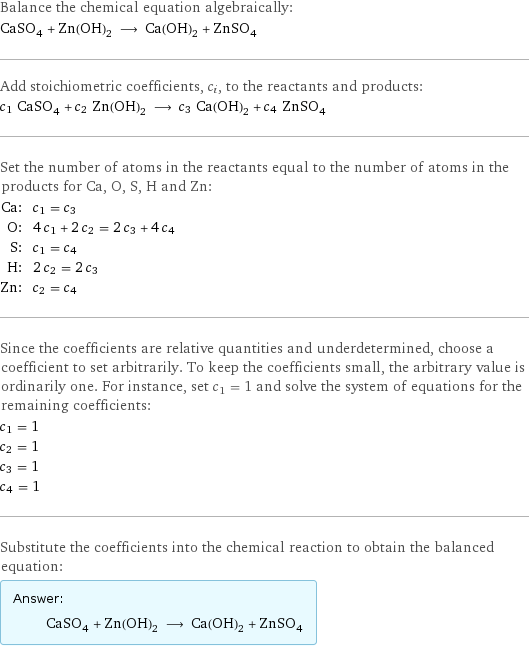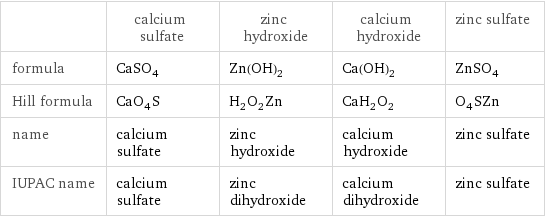Input interpretation

CaSO_4 calcium sulfate + Zn(OH)_2 zinc hydroxide ⟶ Ca(OH)_2 calcium hydroxide + ZnSO_4 zinc sulfate
Balanced equation

Balance the chemical equation algebraically: CaSO_4 + Zn(OH)_2 ⟶ Ca(OH)_2 + ZnSO_4 Add stoichiometric coefficients, c_i, to the reactants and products: c_1 CaSO_4 + c_2 Zn(OH)_2 ⟶ c_3 Ca(OH)_2 + c_4 ZnSO_4 Set the number of atoms in the reactants equal to the number of atoms in the products for Ca, O, S, H and Zn: Ca: | c_1 = c_3 O: | 4 c_1 + 2 c_2 = 2 c_3 + 4 c_4 S: | c_1 = c_4 H: | 2 c_2 = 2 c_3 Zn: | c_2 = c_4 Since the coefficients are relative quantities and underdetermined, choose a coefficient to set arbitrarily. To keep the coefficients small, the arbitrary value is ordinarily one. For instance, set c_1 = 1 and solve the system of equations for the remaining coefficients: c_1 = 1 c_2 = 1 c_3 = 1 c_4 = 1 Substitute the coefficients into the chemical reaction to obtain the balanced equation: Answer: | | CaSO_4 + Zn(OH)_2 ⟶ Ca(OH)_2 + ZnSO_4
Structures

+ ⟶ +
Names

calcium sulfate + zinc hydroxide ⟶ calcium hydroxide + zinc sulfate
Equilibrium constant
![Construct the equilibrium constant, K, expression for: CaSO_4 + Zn(OH)_2 ⟶ Ca(OH)_2 + ZnSO_4 Plan: • Balance the chemical equation. • Determine the stoichiometric numbers. • Assemble the activity expression for each chemical species. • Use the activity expressions to build the equilibrium constant expression. Write the balanced chemical equation: CaSO_4 + Zn(OH)_2 ⟶ Ca(OH)_2 + ZnSO_4 Assign stoichiometric numbers, ν_i, using the stoichiometric coefficients, c_i, from the balanced chemical equation in the following manner: ν_i = -c_i for reactants and ν_i = c_i for products: chemical species | c_i | ν_i CaSO_4 | 1 | -1 Zn(OH)_2 | 1 | -1 Ca(OH)_2 | 1 | 1 ZnSO_4 | 1 | 1 Assemble the activity expressions accounting for the state of matter and ν_i: chemical species | c_i | ν_i | activity expression CaSO_4 | 1 | -1 | ([CaSO4])^(-1) Zn(OH)_2 | 1 | -1 | ([Zn(OH)2])^(-1) Ca(OH)_2 | 1 | 1 | [Ca(OH)2] ZnSO_4 | 1 | 1 | [ZnSO4] The equilibrium constant symbol in the concentration basis is: K_c Mulitply the activity expressions to arrive at the K_c expression: Answer: | | K_c = ([CaSO4])^(-1) ([Zn(OH)2])^(-1) [Ca(OH)2] [ZnSO4] = ([Ca(OH)2] [ZnSO4])/([CaSO4] [Zn(OH)2])](../image_source/dc1095e3ed92eaa4b3cde9e4634321a3.png)
Construct the equilibrium constant, K, expression for: CaSO_4 + Zn(OH)_2 ⟶ Ca(OH)_2 + ZnSO_4 Plan: • Balance the chemical equation. • Determine the stoichiometric numbers. • Assemble the activity expression for each chemical species. • Use the activity expressions to build the equilibrium constant expression. Write the balanced chemical equation: CaSO_4 + Zn(OH)_2 ⟶ Ca(OH)_2 + ZnSO_4 Assign stoichiometric numbers, ν_i, using the stoichiometric coefficients, c_i, from the balanced chemical equation in the following manner: ν_i = -c_i for reactants and ν_i = c_i for products: chemical species | c_i | ν_i CaSO_4 | 1 | -1 Zn(OH)_2 | 1 | -1 Ca(OH)_2 | 1 | 1 ZnSO_4 | 1 | 1 Assemble the activity expressions accounting for the state of matter and ν_i: chemical species | c_i | ν_i | activity expression CaSO_4 | 1 | -1 | ([CaSO4])^(-1) Zn(OH)_2 | 1 | -1 | ([Zn(OH)2])^(-1) Ca(OH)_2 | 1 | 1 | [Ca(OH)2] ZnSO_4 | 1 | 1 | [ZnSO4] The equilibrium constant symbol in the concentration basis is: K_c Mulitply the activity expressions to arrive at the K_c expression: Answer: | | K_c = ([CaSO4])^(-1) ([Zn(OH)2])^(-1) [Ca(OH)2] [ZnSO4] = ([Ca(OH)2] [ZnSO4])/([CaSO4] [Zn(OH)2])
Rate of reaction
![Construct the rate of reaction expression for: CaSO_4 + Zn(OH)_2 ⟶ Ca(OH)_2 + ZnSO_4 Plan: • Balance the chemical equation. • Determine the stoichiometric numbers. • Assemble the rate term for each chemical species. • Write the rate of reaction expression. Write the balanced chemical equation: CaSO_4 + Zn(OH)_2 ⟶ Ca(OH)_2 + ZnSO_4 Assign stoichiometric numbers, ν_i, using the stoichiometric coefficients, c_i, from the balanced chemical equation in the following manner: ν_i = -c_i for reactants and ν_i = c_i for products: chemical species | c_i | ν_i CaSO_4 | 1 | -1 Zn(OH)_2 | 1 | -1 Ca(OH)_2 | 1 | 1 ZnSO_4 | 1 | 1 The rate term for each chemical species, B_i, is 1/ν_i(Δ[B_i])/(Δt) where [B_i] is the amount concentration and t is time: chemical species | c_i | ν_i | rate term CaSO_4 | 1 | -1 | -(Δ[CaSO4])/(Δt) Zn(OH)_2 | 1 | -1 | -(Δ[Zn(OH)2])/(Δt) Ca(OH)_2 | 1 | 1 | (Δ[Ca(OH)2])/(Δt) ZnSO_4 | 1 | 1 | (Δ[ZnSO4])/(Δt) (for infinitesimal rate of change, replace Δ with d) Set the rate terms equal to each other to arrive at the rate expression: Answer: | | rate = -(Δ[CaSO4])/(Δt) = -(Δ[Zn(OH)2])/(Δt) = (Δ[Ca(OH)2])/(Δt) = (Δ[ZnSO4])/(Δt) (assuming constant volume and no accumulation of intermediates or side products)](../image_source/f39afa4813fbece2115521788f24e71c.png)
Construct the rate of reaction expression for: CaSO_4 + Zn(OH)_2 ⟶ Ca(OH)_2 + ZnSO_4 Plan: • Balance the chemical equation. • Determine the stoichiometric numbers. • Assemble the rate term for each chemical species. • Write the rate of reaction expression. Write the balanced chemical equation: CaSO_4 + Zn(OH)_2 ⟶ Ca(OH)_2 + ZnSO_4 Assign stoichiometric numbers, ν_i, using the stoichiometric coefficients, c_i, from the balanced chemical equation in the following manner: ν_i = -c_i for reactants and ν_i = c_i for products: chemical species | c_i | ν_i CaSO_4 | 1 | -1 Zn(OH)_2 | 1 | -1 Ca(OH)_2 | 1 | 1 ZnSO_4 | 1 | 1 The rate term for each chemical species, B_i, is 1/ν_i(Δ[B_i])/(Δt) where [B_i] is the amount concentration and t is time: chemical species | c_i | ν_i | rate term CaSO_4 | 1 | -1 | -(Δ[CaSO4])/(Δt) Zn(OH)_2 | 1 | -1 | -(Δ[Zn(OH)2])/(Δt) Ca(OH)_2 | 1 | 1 | (Δ[Ca(OH)2])/(Δt) ZnSO_4 | 1 | 1 | (Δ[ZnSO4])/(Δt) (for infinitesimal rate of change, replace Δ with d) Set the rate terms equal to each other to arrive at the rate expression: Answer: | | rate = -(Δ[CaSO4])/(Δt) = -(Δ[Zn(OH)2])/(Δt) = (Δ[Ca(OH)2])/(Δt) = (Δ[ZnSO4])/(Δt) (assuming constant volume and no accumulation of intermediates or side products)
Chemical names and formulas

| calcium sulfate | zinc hydroxide | calcium hydroxide | zinc sulfate formula | CaSO_4 | Zn(OH)_2 | Ca(OH)_2 | ZnSO_4 Hill formula | CaO_4S | H_2O_2Zn | CaH_2O_2 | O_4SZn name | calcium sulfate | zinc hydroxide | calcium hydroxide | zinc sulfate IUPAC name | calcium sulfate | zinc dihydroxide | calcium dihydroxide | zinc sulfate
Substance properties

| calcium sulfate | zinc hydroxide | calcium hydroxide | zinc sulfate molar mass | 136.13 g/mol | 99.39 g/mol | 74.092 g/mol | 161.4 g/mol phase | | | solid (at STP) | melting point | | | 550 °C | density | | | 2.24 g/cm^3 | 1.005 g/cm^3 solubility in water | slightly soluble | | slightly soluble | soluble odor | odorless | | odorless | odorless
Units
